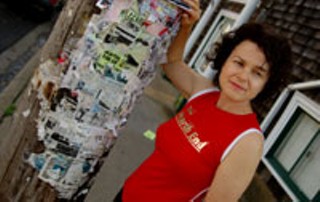Last February, as winter’s chill began to thaw, Cathy Busby took a short walk over to One World Cafe, minutes away from her home near the Common. She observed the posters on the wall promoting various shows and events. In particular, she thought one for Gypsophilia—a striking, swirling design on a black background—was nice. The concert had already happened, so she took the poster home.
And so Busby’s latest art project, The North End—a part of which will be presented at CanZine East on October 21—was born. She collected a few more, about 10. “Then I started assembling them in plastic binders with sleeves. I put them in one at a time, like when you’re a kid with leaves.” She became earnest in her work, going out every few days, expanding her territory to cover more north-end streets. At first, she only picked off the ones that were easy to remove, excavating old ones that had been posted over.
“I had a few rules from the beginning,” Busby explains as she flips through a limited-edition book of 280 posters out of the 300 collected over a four-month period. “I would only take ones from events that already happened. Eventually I started bringing screwdrivers and pliers for pulling out staples, then a box-cutter so if they were taped I could cut them. My bags were the perfect size for holding posters. I developed a little system, which is how I work.”
As she continued to fill the plastic sleeves, something clicked. Busby says, “I realized that there was something here in terms of what it’s saying about the naming of bands and events, things going on in this neighbourhood and all these graphic variations.” At the time Busby was also working on a proposal for Emerson Gallery in Berlin, where she was scheduled to exhibit with partner Garry Neill Kennedy, whose conceptual wall-painting installation Two New Wars, wraps the coloured stripes from the British military medal for the “War on Terror,” with those of the American version. The posters were the perfect microcosmic companion to Kennedy’s globally minded work. “I like the idea of promoting a small, lively community in a place that’s a big, lively community,” she explains.
Busby’s process might seem very simple, but when systematic collection is performed by a professional artist with a PhD in communications, there’s more weight behind its conceptual intent. It’s accumulated from years of experience, of thoughtful investigations into human behaviour in a consume-or-die world that informs Busby’s decisions—even the seemingly minor one to present the pole-art chronologically rather than alphabetically, or by theme or image. But this project also gave the artist something too: a new perspective on her own neighbourhood.
“I was aware of how I was spending time on the street in a way I never did because I would stop. Usually I’m an A-to-B person, so to stop and spend time on the street then meant that people would stop and ask me what I was doing, because it was unusual. That’s how the project really developed.”
“This one was a favourite in Berlin,” Busby says, pointing to a poster from May 19 promoting a gig with Huge, Janus and Man Eating Gaints at Gus’ Pub. Six naked voluptuous women, glorious in rolling flesh, hold hands and dance in a circle. Berliners also observed that Haligonians seem to love birds and other animals. By way of explanation, Busby flips to one for The Kansas Nebraska Act. Retro-inspired wide-eyed foxes, owls and furry creatures frolic around the band’s name. Busby suggests that there is an underlying current of hopefulness lurking behind all the cutesy 1950s images.
“I really like the energy of this hopefulness. Even with the war, global warming and a lack of affordable housing, people are still really hopeful in all different ways. And people are making things happen.”
She also likes the fact that, at first guess, you can’t always tell who has a professional design background—unless you’re looking at the recognizable typographic prowess of Ray Fenwick’s North by North End music festival poster, or at Yo Rodeo!’s bubbly cut-out lettering, layered over a benign yellow floral pattern, designed for a Lighthouse Choir show at Stage Nine. And sometimes artists or activists with art-school training purposely make shitty-looking posters. Busby says, “You couldn’t tell whether it was just the type of drawings that they do, or if they’ve gone through the program at NSCAD, or had some other kind of painting or art background. I haven’t done any analysis. I just collect them as an artist with an anthropological interest in the local history. But I think it’s so great, the way that things are so mixed up.”
There’s a gritty street-level beauty created by the randomness of the posters. Notice how striking a tiny thimble can be when contrasted against a plain white backdrop in the Down with the Butterfly poster, or how sweet a simple blue-and-green globe is when it comes from the paintbrush of Nate and Marcel, or how an earnest poster for a marriage workshop (put on by The Church of Jesus Christ of Latter-Day Saints) transforms into an ironic joke when sandwiched between images of skeletons and riot gear.
At Emerson Gallery, Busby hung all the original posters in a checkerboard pattern. The originals won’t be on display at CanZine, but if all goes well they will be on exhibit at the Art Gallery of Nova Scotia sometime in the future. Busby also made high-end colour copies of the posters and bound 10 copies as a limited-edition book, available for sale along with screenprinted The North End t-shirts that were hot items in Berlin (in Germany, Hamburg is the “north end”) and at the local Go North! studio tour on September 9. But before she left for Europe, Busby sought permission from all of the bands and the people’s names that were mentioned on the posters. Based on an idea she took from the New York Times literary supplement, Busby made her own pole poster with the bold headline “ARE YOU HERE?”, which listed all of the names found on the posters, her intentions and email address, and hung it around the neighbourhood. Busby heard back from about 10 different people and spoke to many more in person. No one had a problem.
Last September, in a rather ironic turn of events, Busby went to the Halifax North Memorial Library to see The Right Thing to Do: Our Neighbourhood in Words and Pictures, a collection of historic north-end photos and documents assembled by the Creighton/Gerrish Development Association. There, in the entrance to the exhibition, was a blown-up version of a poster that Busby designed herself in 1985, under the moniker The Halifax Poster Project.
Designed to draw attention to pressing social issues and to act as a place for non-profits to promote their contact information— these were pre-internet days—this poster has a black-and-white photo of MUMS, (Mothers United for Metro Shelter), protesting for affordable housing in the city. At her home, Busby carefully pulls original copies out from a cardboard sheath. In its simple legacy it’s clear why postering is so important to a city’s social and cultural wellbeing—these issues don’t go away. “It’s also a form of educational democracy,” Busby explains. “It doesn’t require qualifications, like in a gallery. And as a city, you have to support a wide range of things that come into various economic levels. If you want authentic cultural sensibility, you need to let it happen, without professional fundraising or financial backing.” In other words, anyone with any kind of educational experience should be able to make a poster, get it photocopied and advertise their event around Halifax.
The Supreme Court of Canada thinks so, too. Postering is protected under the Canadian Charter of Rights and Freedoms, although the right to staple has been challenged by cities from coast to coast. “But who wants to get charged under a stupid municipal bylaw and then take it to the Supreme Court?” Busby asks. After Peterborough, Ontario, musician Ken Ramsden did just that—he fought the law and he won—the court also declared that cities can get around the ruling if they provide other places for postering to take place. In Halifax’s case, it’s those centralized poster kiosks such as the one in front of the Spring Garden Library, or on Quinpool Road, which Busby says counteracts the organic nature of how communities flourish. She says they need to be “able to permeate through the neighbourhoods. That’s a really good thing.”
Which is what Busby told a couple of police officers she met while out collecting. They assumed that she was being a good citizen by cleaning the poles and were surprised to hear differently. “I said to them, ‘Isn’t this great?’ I explained that I was doing a show in Berlin and this is just so indicative of the cultural vibrancy here. They looked at me like ‘huh?’” Busby laughs. “It is a simple thing to do but no one had ever done it. I think it was a valuing of that ephemera that really clicked with people and made them think, ‘Yeah, all this activity is neat. Just look at all these posters.’”
Cathy Busby’s The North End at CanZine, September 21 at St. David’s Church Hall, 1537 Brunswick, noon-6pm, $5, includes copy of Broken Pencil.

















